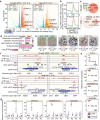Stress-induced nuclear translocation of ONAC023 improves drought and heat tolerance through multiple processes in rice
- PMID: 38997294
- PMCID: PMC11245485
- DOI: 10.1038/s41467-024-50229-9
Stress-induced nuclear translocation of ONAC023 improves drought and heat tolerance through multiple processes in rice
Abstract
Drought and heat are major abiotic stresses frequently coinciding to threaten rice production. Despite hundreds of stress-related genes being identified, only a few have been confirmed to confer resistance to multiple stresses in crops. Here we report ONAC023, a hub stress regulator that integrates the regulations of both drought and heat tolerance in rice. ONAC023 positively regulates drought and heat tolerance at both seedling and reproductive stages. Notably, the functioning of ONAC023 is obliterated without stress treatment and can be triggered by drought and heat stresses at two layers. The expression of ONAC023 is induced in response to stress stimuli. We show that overexpressed ONAC23 is translocated to the nucleus under stress and evidence from protoplasts suggests that the dephosphorylation of the remorin protein OSREM1.5 can promote this translocation. Under drought or heat stress, the nuclear ONAC023 can target and promote the expression of diverse genes, such as OsPIP2;7, PGL3, OsFKBP20-1b, and OsSF3B1, which are involved in various processes including water transport, reactive oxygen species homeostasis, and alternative splicing. These results manifest that ONAC023 is fine-tuned to positively regulate drought and heat tolerance through the integration of multiple stress-responsive processes. Our findings provide not only an underlying connection between drought and heat responses, but also a promising candidate for engineering multi-stress-resilient rice.
© 2024. The Author(s).
Conflict of interest statement
The authors declare no competing interests.
Figures










References
-
- Hall C, Dawson TP, Macdiarmid JI, Matthews RB, Smith P. The impact of population growth and climate change on food security in Africa: looking ahead to 2050. Int. J. Agr. Sustain. 2017;15:124–135. doi: 10.1080/14735903.2017.1293929. - DOI
-
- Peng G, Bai J, Wang J. Relationships between biochemical qualities of paddy rice and climate conditions in the Anning River Valley. J. Appl. Ecol. 2004;15:2277–2281. - PubMed
-
- Tian XH, et al. Heat-induced floret sterility of hybrid rice (Oryza sativa L.) cultivars under humid and low wind conditions in the field of Jianghan Basin, China. Plant Prod. Sci. 2010;13:243–251. doi: 10.1626/pps.13.243. - DOI
MeSH terms
Substances
Grants and funding
LinkOut - more resources
Full Text Sources
Molecular Biology Databases

